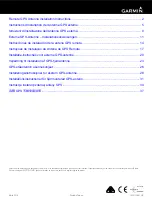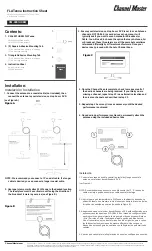
Site Survey
ST94-21 C/Ku-Band TVRO
2-4
2.5.
Mast Configurations
Sea Tel recommends the ADE be mounted on the ship in a location which has both a clear line-of-sight to the target
satellites in all potential azimuth/elevation ranges and sufficient support against vibration excitement. If possible,
mounting the ADE pedestal directly to ship deckhouse structures or other box stiffened structures is preferred.
However, in many cases, this imposes limits on the clear line-of-sight the antenna system has.
Often the solution for providing the full azimuth/elevation range the antenna needs is to mount the ADE on the ship’s
mast. Unfortunately, masts do not consider equipment masses in design and often have harmonic frequencies of their
own.
For these large systems, the mast for the ADE should be designed specifically for the ADE. Other equipment may be
mounted alongside, but the mast should be configured to accept the mass, loads and resonance of the ADE primarily.
The following sections describe various mast configurations and some considerations for mast design.
2.5.1.
Vertical Masts
Vertical masts are a very ancient and common mast design. In essence, it is the mast derived from the sailing
mast, adapted for mounting the ever-increasing array of antennae ships need to communicate with the
world. This drawing of a Vertical mast shows
preferred mounting of the ADE center-line above
the plane of the radar, or as an alternate with the
ADE mounted below the plane of the radar signal,
as reasonably good installations of a satellite
antenna ADE.
Vertical masts are most commonly still found on
cargo ships – they are simple, inelegant and
functional. They are also fairly stiff against
torsional reaction and lateral vibrations, as long as
the ADE is mounted on a stiff pedestal near the
vertical centerline of the mast. If centerline
mounting is impractical or otherwise prohibited,
the mast platform the ADE is mounted on should be checked for torsional vibration about the centerline of
the mast and the orthogonal centerline of the platform.
If the estimated natural frequency of the mast or platform is less than 35 Hertz, the mast or platform should
be stiffened by the addition of deeper gussets under the platform or behind the mast.
2.5.2.
Raked Masts
Raked masts are found on vessels where the style
or appearance of the entire vessel is important.
Again, the inclined mast is a direct descendant from
the masts of sailing ships – as ship owners wanted
their vessels to look more unique and less
utilitarian, they ‘raked’ the masts aft to make the
vessel appear capable of speed. This drawing
shows a raked mast, again with the preferred ADE
mounting above the radar and alternate with the
ADE below the radar.
Raked masts pose special problems in both
evaluating the mast for stiffness and mounting of
antennae. As can be seen in the drawing all
antennae must be mounted on platforms or other
horizontal structures in order to maintain the
vertical orientation of the antenna centerline. This
implies a secondary member which has a different
natural frequency than the raked mast natural frequency. In order to reduce the mass of these platforms,
they tend to be less stiff than the main box structure of the raked mast. Thus, they will have lower natural
frequencies than the raked mast itself. Unfortunately, the vibratory forces will act through the stiff structure
of the raked mast and excite these lighter platforms, to the detriment of the antenna.
EAR Controlled - ECCN EAR99
Summary of Contents for ST94-21
Page 4: ...EAR Controlled ECCN EAR99 ...
Page 10: ...Table of Contents x This Page Intentionally Left Blank EAR Controlled ECCN EAR99 ...
Page 123: ...EAR Controlled ECCN EAR99 ...
Page 126: ...EAR Controlled ECCN EAR99 ...
Page 139: ...EAR Controlled ECCN EAR99 ...
Page 140: ...EAR Controlled ECCN EAR99 ...
Page 141: ...EAR Controlled ECCN EAR99 ...
















































